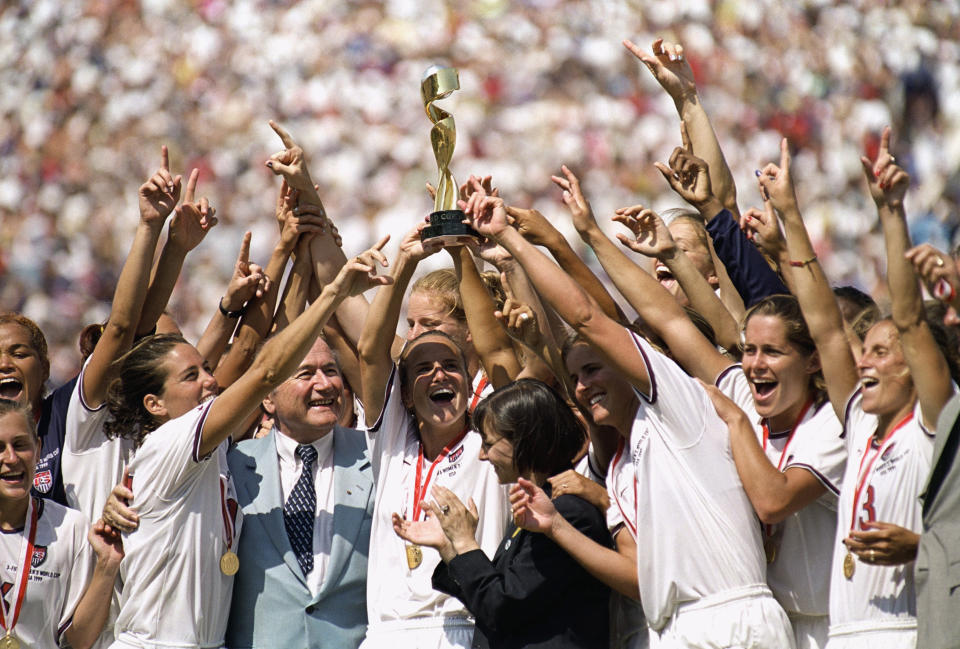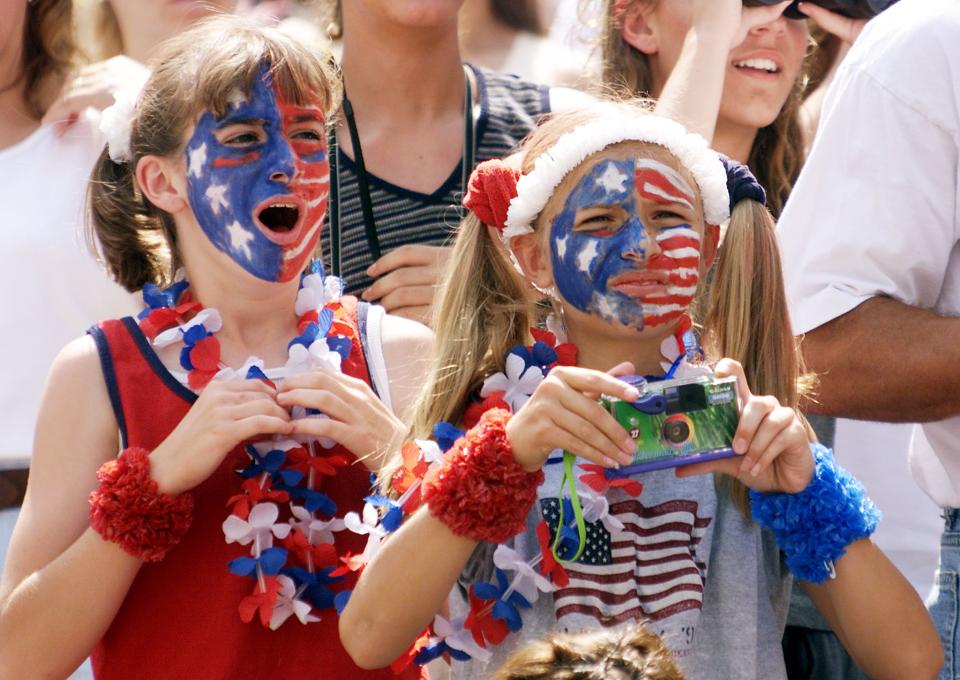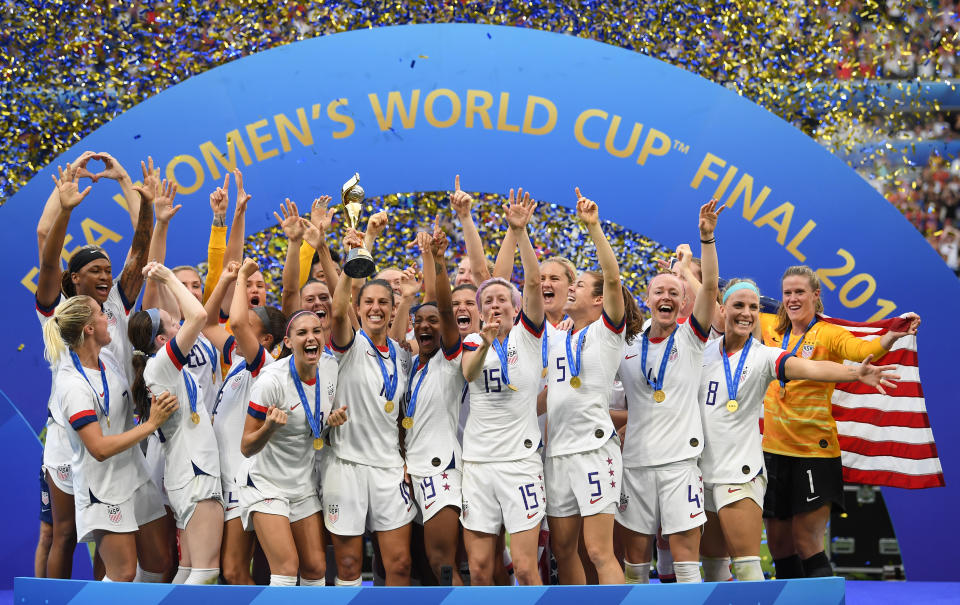How the USWNT became the most influential women's team in sports

There was something different about the crowd that filled Giants Stadium on June 19, 1999.
For one thing, it was the most people who had ever packed into the stadium for a sporting event — more than the New York Giants ever drew.
But what especially stood out about the sea of people who gathered to watch World Cup soccer was the sound of the crowd’s roar. It didn’t sound like a Giants game — there were old voices mixed with young ones, male voices and female voices alike.
That game at Giants Stadium was the opener of the 1999 Women’s World Cup, and the first step for the U.S. women’s national team to become one of the most important collectives in sports. By the tournament’s end — after the U.S. beat China on penalty kicks and Brandi Chastain ripped off her shirt in celebration — the USWNT had reserved a new and special place in history.
Sure, that team had Mia Hamm, who became a household name. And it would later have superstars like Abby Wambach, Hope Solo and Megan Rapinoe. But what made the USWNT special was that it was a group of women working together, which had never captured the attention of America before.
“It was a team that had superstars but it was also a team that had chemistry, that fought for each other and played for each other,” said 1999 Women’s World Cup play-by-play announcer JP Dellacamera during an interview for the book The National Team. “Whenever you interviewed Mia Hamm and wanted her to talk about her greatness, she’d talk about her teammates. That ’99 team was as together of a team as I’ve ever seen.”
That was why the USWNT became the first group of women to transcend sport, age or gender, collectively becoming heroes to Americans from all walks of life. And it’s why still today, the USWNT remains perhaps the most important and influential women’s team in all of sports.
Changing perceptions
When the USWNT first arrived to the mainstream American public in 1999 for the World Cup, it was unusual to see a group of strong female athletes sharing the spotlight.
The media didn’t quite know how to discuss them, calling the players “babes” and comparing their games to beauty pageants. Early in the tournament, a reporter asked Chastain point blank if the team would have attracted so many new fans if they weren’t so attractive.
But somewhere between Hamm’s sensational opening goal against Denmark and Chastain’s iconic penalty kick, people realized the USWNT was a collection of impressive athletes but, even better than that, together they brought out the best in one another.
“These were very strong women who were working as a team, and there was this notion that women can’t be team players,” said 1999 Women’s World Cup organizer Donna de Varona for The National Team. “We are team players. It reinforced all the things that we are capable of and can do through sport.”
After all, history books are filled with outstanding individual female athletes who have taken over the sports world, from Billie Jean King to Serena Williams, from Shannon Miller to Simone Biles. The most famous female athletes stood on their own as a singular focal point.
But for the first time, the biggest star in the sports world was a group of women fighting in the trenches together. That in and of itself started to change the way people thought about athletes, and the way young girls thought about themselves.

“We’d go to the movies and girls would be crying, and we were like, ‘Why are you crying?’ and they’d say ‘We’re so excited and nervous to see you guys,” said former USWNT captain Julie Foudy in a previously unreleased interview for The National Team. “That’s when you realized the impact, in such a good way, you can have on people. That’s the power of sports.”
“We always had the big picture in mind — why we were doing it,” Foudy added. “Yes, it was about winning and being successful, but we always felt the most satisfaction out of the fact that we were changing the way people perceived women’s sports and that we were inspiring that many more girls. None of us had female role models growing up. Mine were basketball players and football players who were 7 feet tall and 300 pounds.”
A lasting impact
The crowd in Lyon, France last summer sounded a lot like the crowd in 1999. After the USWNT won its fourth World Cup against the Netherlands, there were men and women of all ages and backgrounds cheering for the Americans.
But the cheers were different. This time, there was a message.
“Equal pay! Equal pay!”
Some players couldn’t decipher the chant right away. After all, it sounded so similar to “U-S-A! U-S-A!” But soon it became clear. The fans didn’t just care about winning another trophy — it was so much bigger than that.
Yes, the USWNT was still drawing massive crowds and setting TV ratings records as the preeminent women’s sports team in perhaps in the entire world. But now the USWNT’s influence started to permeate more parts of culture, sparking new conversations.
“We are willing to fight,” USWNT defender Ali Krieger said after the 2019 World Cup final. “We just love to play this game but we also understand we have somewhat of a responsibility to uphold and being a role model for people who maybe don’t have a voice, not only in football but in important issues that are happening around us.”
Months earlier, the players on the USWNT joined as a united front and filed a lawsuit against their boss, the U.S. Soccer Federation, alleging gender discrimination. Their allegations weren’t all that different than things women have experienced in workplaces across the country.
It was a gutsy and perhaps even a risky thing to do ahead of the sport’s most important tournament. But the players did it together, the way they’ve fought all of their other battles. And they arrived in France more cohesive and more united than perhaps ever before — at least not since the 1999 team.
While the lawsuit against U.S. Soccer is complicated, speaking out for equal pay is not.
It’s true that the USWNT is perhaps the most well-resourced women’s soccer team in the world, but that only happened because the players, as a unit, pushed U.S. Soccer to fund them.
Back in 2000, every player on the USWNT agreed to boycott a tournament to force U.S. Soccer to pay them something close to a living wage. When U.S. Soccer called on youth players to fill the vacancies, all of the youth players joined in the protest.
The team that had just won the 1999 World Cup knew it was stronger together than as individuals. The players eventually won that fight, and U.S. Soccer was powerless to go up against a group of united women.
That is how the team has won all of its battles, both on the field and off of it: together, united and putting the team ahead of any one individual.
It’s unclear what will happen with the USWNT’s ongoing lawsuit against U.S. Soccer. The trial has been pushed back and a settlement looks all the more likely. And with the Olympics pushed to 2021 amid the COVID-19 pandemic, the schedule ahead for the USWNT is uncertain.
But whatever the USWNT does next, it will be together as a team. And when the USWNT fights together, it’s something special.
Caitlin Murray is a contributor to Yahoo Sports and her book about the U.S. women’s national team, The National Team: The Inside Story of the Women Who Changed Soccer, is out now. Follow her on Twitter @caitlinmurr.



